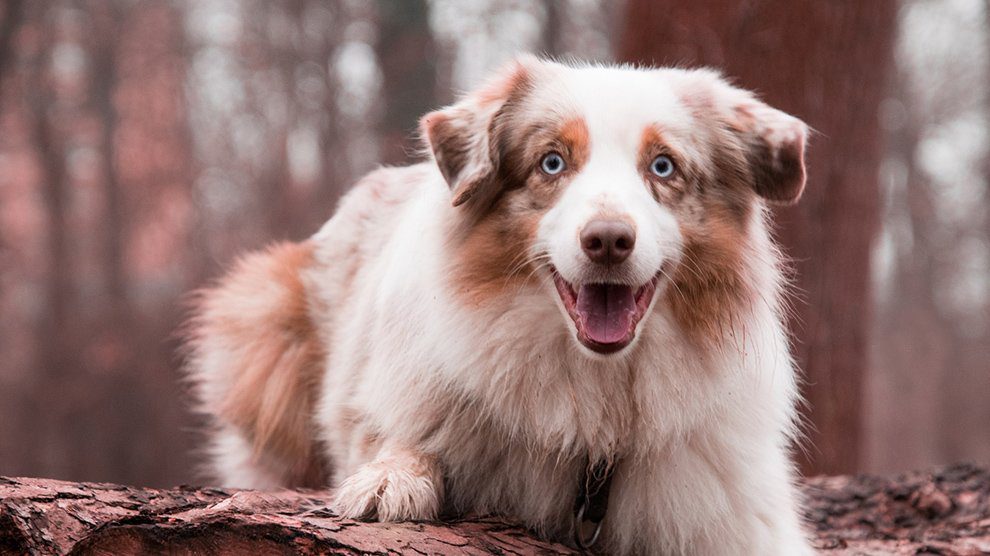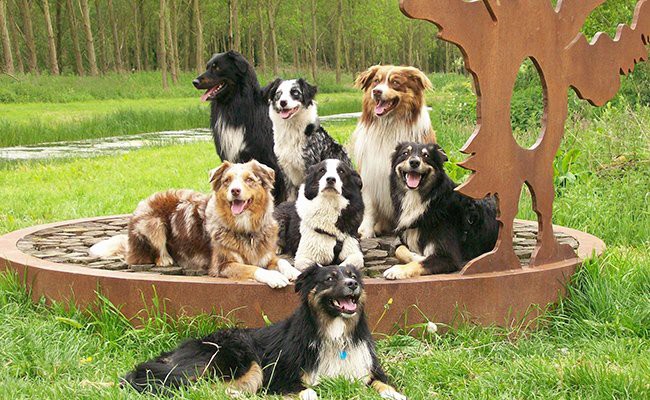Dog Pregnancy Calculator And Timeline
Do you know that the Australian Shepherd is a herding dog breed that does not originate from Australia? Basque shepherds first bred them in the USA. Basque is a country in Western Europe.
Australian Shepherd puppy gained popularity in the western countries due to the television shows, horse shows, and rodeos held in those nations.
Australian Shepherd Breed Characteristics
- Origin: United States of America
- Size: Medium
- Dog Breed Group: Herding
- Purebred: Yes
- Lifespan: 12 to 15 years
- Height: 20 to 23 inches (males), 18 to 21 inches (females)
- Weight: 50 to 65 pounds (males), 40 to 55 pounds (females)
- Coat Appearance: Medium length, Straight, Smooth, Water-resistant
- Coat Colors: White, Black, Liver, Tan, Blue Merle, Red Merle
- Temperament: Loyal, Intelligent, Gentle, Affectionate, Playful
- Good With Children: Yes
- Intelligence Level: High
- Good With Pets: Yes
- Hypoallergenic: No
- Grooming: High
- Shedding: High
- Barking: High
- Suitable For Apartments: No
- Need For Exercise: High
- Easy To Train: Yes
- Good For First Time Owners: Moderate
- Health Issues: Hip dysplasia, Epilepsy, Cataract, Hypothyroidism, Progressive Retinal Atrophy
- Litter Size: 6 to 9 puppies
- Average Price: $600 to $1000
Australian Shepherd Facts
Appearance
The Australian Shepherd puppy has a medium-sized, well-balanced, and strong body. Its overall size is at an equal level with the body. The eyes of an Australian Shepherd look like an almond, and it is often seen in colors like blue, brown, and amber.
The dog has straight ears that go above the head and look triangular. Australian shepherd dogs have docked tails, which usually appear full and lengthy at the time of their birth.
Australian Shepherd Color
The coat colors of an Australian Shepherd puppy is usually seen in a combination comprising of
- Two primary body colors such as black and liver
- Two trim colors: white and tan
- Merle pattern colors in two forms: blue merle and red merle
Australian Shepherd Mix Breeds
Australian Shepherd dogs can be cross-bred with various purebred dog breeds. The mix-breed dogs are for sure, adorable pets that have great personalities of the parent breeds.
- Augi – Australian Shepherd and Pembroke Welsh Corgi
- Aussiedoodle – Australian Shepherd and Poodle mix
- Australian Retriever – Australian Shepherd and Golden Retriever
- Baussie – Australian Shepherd and Boston Terrier
- Border – Aussie – Australian Shepherd and Border Collie
- Ausky – Australian Shepherd and Husky
- Boxherd – Australian Shepherd and Boxer
- Shepnees – Australian Shepherd and Great Pyrenees
- Auberman – Australian Shepherd and Doberman
- Chow Shepherd – Australian Shepherd and Chow
- Sheagle – Australian Shepherd and Beagle
- Dachsherd – Australian Shepherd and Dachshund
- Dalshep – Australian Shepherd and Dalmatian
- Aussiel – Australian Shepherd and Cocker Spaniel
Australian Shepherd Size
Male Australian shepherd dogs can grow from 51 to 58 cm while the females grow from a height of 46 cm to 53 cm
Likewise, the size of a male dog is between 18 to 23 kg while the female dog is 14 to 20 kg
Australian Shepherd Lifespan
Typically, the expected lifespan of an Australian Shepherd dog ranges from 12 to 15 years. But you must bear it in mind that this applies only to healthy and happy dogs that are grown in the right environment.
Australian Shepherd Food
Australian Shepherds are highly dynamic dogs that require highly nutritious food.
Generally, protein is recommended by vets and various related professional associations to be a key component in the diet given to a dog.
Fats must also constitute a reasonable portion of the diet.
Australian Shepherd Food
- Kibbles
- Raw vegetables like carrots, lettuce, green beans
- Fruits like apples and oranges (minced pieces)
- Cheese
- Plain Rice
- Yogurt
- Baked Boneless Chicken
- Fish
- Beef
- Lamb
- Salmon
- Duck
- Turkey
- Eggs (cooked)
- Chickpeas
“Do not Eat” Foods For Australian Shepherd
- Chocolates
- Avocados
- Grapes and Raisins
- Hops
- Mushrooms
- Garlic
- Onions
- Tobacco
- Raw eggs
- Nuts
- Almonds
- Seeds
- Potato Stems
Australian Shepherd Training
Training your Aussie is relatively easy because of its intelligence, energy, and loyalty. As every dog has specific needs, you should know the training requirements of this breed!
Obedience Training
Aussies may develop destructive behaviors such as nipping and chasing herding nature. Obedience training will help them to avoid these behaviors while they grow.
Early Socialization
Socializing with this dog at an early age will allow him to get along with other pets. As they have a herding instinct from birth, this will help them to be not overprotective.
Reward-based Training
This training works well for almost any dog breed. You can appreciate it by giving dog treats and the food they love.
This will help him to be happy and do well in trials.
Exercise
Aussies are energetic breeds. They want themselves to indulge in high-energetic activities such as Frisbee, agility trails, running, etc.
Besides, this breed should get daily activities for mental stimulation. So, allow your Aussie to play for at least 30 to 60 minutes a day.
But, you have to ensure a few things while they play or do exercises.
- Ensure that your dog is playing in a secure, fenced yard so that it won’t dig or jump over the yard.
- Always keep it on a leash while walking.
Australian Shepherd Care
Caring for this breed involves proper grooming needs and regular checkups with the vet.
Aussie’s coat tends to form mats or tangles. So, regular brushing is essential for this dog!
Also, you need to provide daily activities to this energetic breed to stay healthy!
Besides, you need to provide immediate veterinary attention in cases of any physical abnormalities in it.
Australian Shepherd Shedding And Grooming
Australian Shepherd is a seasonal shedder, especially heavy during the spring season. So, grooming needs will be more during the shedding season.
- Brush its double-layered coat at least weekly once using a wire-pin brush to keep the coat glossy!
- During the shedding season, brush the coat using an undercoat rake once in 2 to 3 days to remove the dead hairs.
- Comb the hairs behind the ears using the stripping comb to prevent matt formation,
- Need to give bath to this dog when it is dirty using a dog shampoo and using lukewarm water.
- Check the eyes for any discharge.
- Check the ears for infections and clean them using a damp cloth.
- You have to trim its nails regularly.
If you want your dog to have a short coat, trim the hairs around the ears, tail area and on the feet, and between the toes. You can also take it to a professional groomer to make it coat short!
But, don’t shave the coat of the Australian shepherd as it may get sunburns.
Australian Shepherd Puppy Names
Scanning for a unique name for your newly added family member. Check out our wide selection of ideas on naming your extremely lovable dog breeds with beautiful eyes.
| Male Dogs | Female Dogs |
|---|---|
| Charlie | Gracie |
| Bear | Abby |
| Jack | Brandy |
| Lucky | Candy |
| Max | Ebony |
| Matt | Crimson |
| Duke | Mercy |
| Samuel | Scarlet |
| Rudy | Reba |
| Tzar | Tasha |
Australian Shepherd Temperament
- Gentle
- Adaptable
- Active
- Intelligent
- Affectionate
- Playful
- Cautious
- Responsive to training
- Loyal
- Aggressive and barks a lot (if left in loneliness)
Interesting Facts About Australian Shepherd
- Many people think that the Australian Shepherd is a native dog from Australia. They are wrong because this dog breed’s origin is Basque, a country in Western Europe.
- In 2016, according to the American Kennel Club, the Australian Shepherd dog was the 18thmost popular dog in America
- Australian shepherd dogs on average can give birth to 7 puppies
- Mostly, Australian shepherd dogs have a passion for swimming. These dogs also like to play fetch games in the water.
- Certain Native American tribes call the Australian Shepherd puppy “the ghost-eye dog” since its eyes are so bright
- Many Aussie (Australian Shepherd) dogs were used as saving dogs in the search and rescue operations post “9/11” terrorist attacks in America
- Australian Shepherd dogs are good jumpers that can jump up to a height of 3 ft to 4 ft. Owners must keep this in mind while building a fence
- Aussies are frequently called Velcro dogs because of their close attachment to the owner. These dogs develop a strong affinity with a few people.
- Australian Shepherd doggies have that natural tendency to herd, and so they can even suddenly chase small animals like cats, rabbits, and birds.
- It is a real multipurpose dog that can be used for various tasks: herding, rescue, therapy, assistance, search, and guide.
Australian Shepherd Common Health Issues
Some of the health problems Australian Shepherds suffer are discussed below.
1. Hip Dysplasia

Symptoms
The Australian Shepherd affected with hip dysplasia shows signs like:
- Difficulty in getting up
- Finding it tough to climb the staircase
- Avoidance of routine activities
- Changes in Gait
- Avoids full extension of its hind (back) legs
- Stiffness and pain in the rear legs after exercising
- Loss of muscle mass in the thighs
- The probability of the dog becoming unable to walk
Causes
- Genetic Factors
- Poor or malnutrition
- Obesity
- Heavy exercise or no exercise
Treatment
- Recommended changes in diet – Add a more nutritious diet and avoid excess carbohydrates, proteins, and fat-related foods
- Changes in exercise routine – Weight loss exercises to decrease the strain in the hip joints. A heavy or obese dog is more exposed to hip dysplasia disorder.
- Medications – Anti-inflammatory and pain reduction medicines are usually recommended. Medications that can correct the damaged cartilage are also prescribed
- Hip replacement surgery – The most frequently heard method that is so popular and highly effective (significant success rate). Early surgery will be valuable in stopping the severity of joint diseases in a dog.
2. Cataracts

Symptoms
- Bluish-grey cloudiness appears on the pupils
- The abnormal coloration of the eye such as grey and blue
- Vision loss symptoms which comprise:
- The accidental collision of its head with furniture, door frames, and other objects in the house
- Barking at non-living objects
- Unbalanced slow walk with the nose pointing down to the ground
- The sense of high caution coupled with fear while walking
- Experience difficulty in locating its food and water bowls
Causes
- Pain in the eye due to some injury or accident
- Diabetes
- Uveitis
- Exposure to toxic chemicals
- Age-related macular degeneration
Treatment
Usually, surgery is the only effective method to be applied to the date for treating cataract disease. However, the veterinarian will only perform surgery on healthy dogs, i.e. dogs that have cataract disease and do not suffer from diabetes and other chronic diseases.
The veterinarian surgeon will suggest immediate surgery for such dogs to avert severe problems like complete blindness.
3. Epilepsy
Symptoms
- Behavioral changes
- Head shaking
- Paddling of legs
- Teeth chewing
- Incontinence (urine or poop)
- Excess drooling in the mouth
- Contraction of muscles
- Experience loss of vision for some time
- Loss of consciousness
- Falling down on one side
Causes
- Genetic factors
- Injury
- Brain Tumor
- Defects in somebody organs
- Toxic exposure
Treatment
A careful study by the veterinarian about the overall health conditions of the dog and the type of seizures will only determine the nature of the treatment. However, a diet plan could be recommended by the veterinarian for a dog with seizures.
This applies more to dogs that have been suffering from seizures for a reasonably long time. The vet charts the diet plan for a dog after careful study of its weight. As dogs with long-term epileptic conditions gain excess weight.
Medications like antiepileptic drugs, anticonvulsants, and corticosteroids are known to lessen the frequency of seizures. Surgery is usually done to remove the tumors formed in epileptic dogs.
4. Cancers
Symptoms
- Weakness
- Unhealed Wounds
- Tough to swallow food
- Loss of Appetite
- Weight loss
- Bleeding from any noticeable part of the body
- The body continues to be in a stiff state leading to difficulty in movement
- Reluctance to exercise
- Feeling difficult to do routine bodily activities like breathing, eating, urinating, and defecating
Causes
- Hereditary factor
- Poor quality of diet
- Overvaccination
- Exposure to ultraviolet rays from the sun
- Exposure to toxic chemicals, smoke, and other pollutants in the environment
Treatment
Cancer is a disease that is mostly treated by surgical methods, but it depends on the stage of cancer. Cancer will require surgical intervention. If something bad is growing inside your dog at a rapid pace, surely it must be removed.
However, chemotherapy and radiation therapy are also widely used methods in the treatment of cancer, which are in mild and moderate stages.
5. Hypothyroidism
Symptoms
- Skin thickening and drying
- Higher skin pigmentation
- Hair Loss
- Reluctance to exercise
- Inability to live in cold temperatures
- Lethargy
- Aggressive behavior
- Ear and skin infections like cauliflower ear that result in itchiness
Causes
- Poor diet
- Autoimmune thyroiditis where the body attacks its own thyroid gland
- Toxic medicines
- Exposure to environmental toxins
- Atrophy of the thyroid gland
Treatment
The usual treatment method for hypothyroidism is to give oral medications to the dog-like administering the drug, synthetic L-thyroxine (L-T4) into its mouth. This is a lifelong treatment for the dog, and the medicine must be given daily either once or twice.
This disease does not endanger your dog’s life but it must be necessarily treated to improve the quality of life of the dog. Normally, this medication is followed for 4 to 6 weeks.
Thereafter, good results like a decrease in hair loss level and other improvements will be seen in the dog.
Australian Shepherd Price And Breeders
The average price of an Australian Shepherd in the USA market is between $600 and $1000. Various factors play a role in the price fixation of a dog such as its age, parents, vaccination scale, overall quality, nature of breeder who sells it, and the location.
If you take the UK market, the price of an Australian Shepherd puppy is between £500 and £900. The same factors stated for the price fixation earlier are very much applicable here.
Breeders Who Sell Australian Shepherd
Check out the complete list of Australian Shepherd Dog Breeders in your area.






















